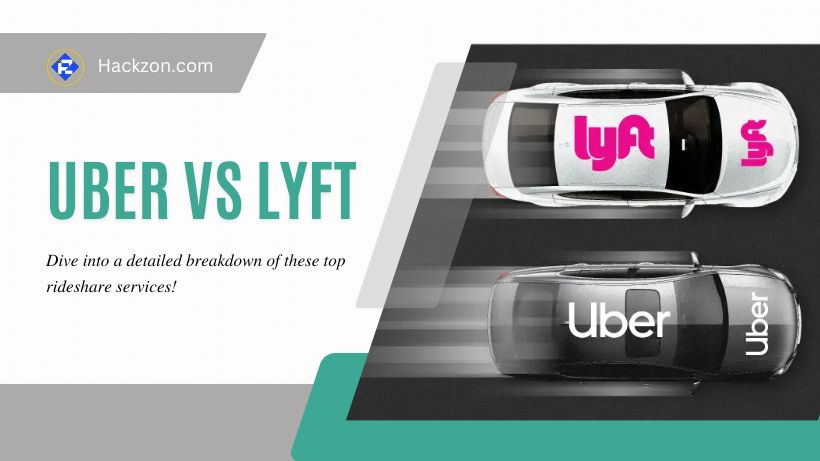Reviews
Uber vs Lyft: Which Rideshare Service is Better for You
🚗 Uber vs Lyft: Dive into a detailed breakdown of these top rideshare services to find out which one suits your daily travel needs best! 🏙️💼

Ridesharing services have appeared as the preferred option for practical and effective transportation in today’s hectic environment.
Uber vs Lyft stand out as the two main competitors among the many choices available, vying for the favors of both drivers and passengers.
But which service is truly better for you? To assist you in making an educated decision, Hackzon will thoroughly examine the main distinctions, features, affordability, safety, driver compensation, and more in this post.
Uber vs Lyft: A Detailed Comparison for Riders and Drivers
Uber, founded in 2009, revolutionized the transportation industry by introducing app-based ride-hailing.
With its distinctive pink mustache logo and a more community-focused strategy, Lyft swiftly followed after its 2012 launch. Uber operates in over 70 countries, while Lyft focuses primarily on the U.S. and Canada.
Both businesses strive to offer dependable transportation, but they differ in how they promote and run their businesses.
Lyft tends to project an approachable and pleasant image, whereas Uber frequently positions itself as a premium service.

1. Uber vs Lyft: Which is More Affordable?
Affordability often depends on factors like location, time of day, and demand. Uber and Lyft have similar pricing structures, including base fares, per-mile rates, and surge pricing during peak hours.
For instance, a 5-mile trip might cost $10 on Uber and $9.50 on Lyft during regular hours, but surge pricing could flip those numbers.
Lyft occasionally offers loyalty discounts through its “Lyft Pink” subscription, while Uber provides upfront fare estimates and rewards through its Uber Rewards program.
2. Uber vs Lyft: Comparing Features and Ride Choices
Both Uber and Lyft offer diverse ride options:
- Uber: UberX, UberXL, Uber Black, Uber Comfort, and Uber Pool (in select locations).
- Lyft: Lyft Standard, Lyft XL, Lux, Lux Black, and Shared Rides.
Uber’s app is praised for its advanced features like scheduled rides, real-time ETAs, and integration with Uber Eats.
The Lyft app is easy to use and offers features like round-up charitable donations. Driver ratings, fare sharing, and trip scheduling are all possible with both applications, although Uber’s UI generally offers greater personalization.
3. Uber vs Lyft: Which is Safer?
For both drivers and riders, safety comes first. In addition to offering real-time trip monitoring, two-way ratings, and emergency assistance buttons inside their applications, Uber and Lyft both run background checks on drivers.
Uber’s safety measures include a PIN verification feature, while Lyft emphasizes driver coaching programs.
According to customer feedback, both services are safe, although individual rides and locales may differ.
4. Uber vs Lyft: Who Pays Drivers Better?
Driver earnings depend on factors like trip length, location, and tips. Both Uber and Lyft take a percentage of the fare as commission, but the exact amount varies.
Lyft is often praised for its driver-friendly culture, offering perks like Express Pay and rental car options.
In some locations, Uber offers incentives like surge bonuses and a greater selection of trip possibilities, which can result in increased profits.
According to driver reports, the two services’ pay parity varies greatly depending on the area.
5. Uber vs Lyft: Who Handles Complaints Better?
Customer support plays a crucial role in user satisfaction. Uber and Lyft both include in-app complaint mechanisms, although response times and issue resolutions might vary.
Uber’s worldwide scale enables it to offer 24-hour help, but Lyft’s customer care is recognized for being more customized.
Some riders like Lyft’s compassionate attitude, while others value Uber’s efficiency in addressing concerns.
6. Uber vs Lyft: Where Can You Ride?
Uber operates in over 10,000 cities worldwide, making it the go-to choice for international travelers.
Lyft’s availability is limited to the U.S. and select Canadian cities, but it often has stronger coverage in suburban and rural areas compared to Uber. Your location will largely determine which service is more accessible.
7. Uber vs Lyft: What Do Riders Prefer?
App experience, driver professionalism, and ride availability all influence rider choices.
Surveys show that Uber is often preferred for its premium options and international reach, while Lyft wins over riders with its friendly vibe and slightly lower fares.
In the end, tastes differ based on personal priorities.
Wrapping Up!
Choosing between Uber and Lyft comes down to your specific needs. If you value worldwide availability and premium features, Uber may be the best alternative.
If price, a pleasant experience, and suburban coverage are more important, Lyft may be the victor.
Both services have advantages, so why not test both and decide for yourself? What is your experience using Uber and Lyft? Please share your opinions in the comments!
















